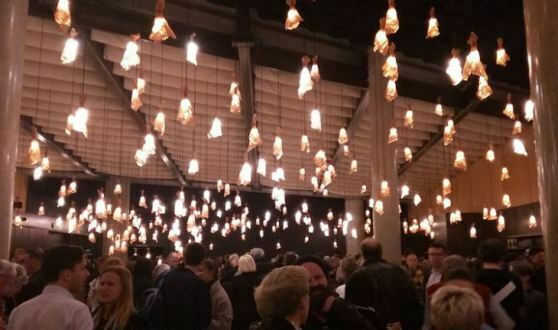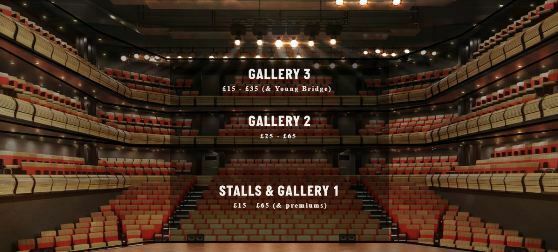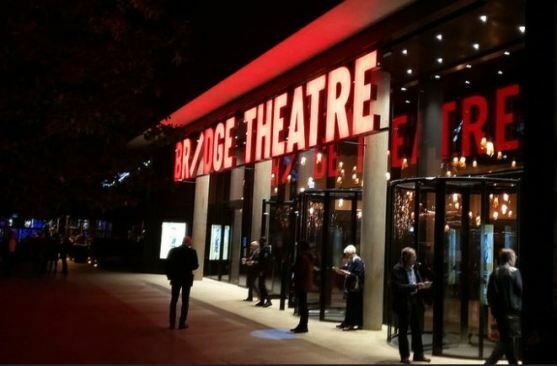
The Bridge. It’s a good name for a theatre. It makes you think of those plain, bold, striking names given to London’s theatres in Shakespeare’s time: The Globe, The Rose, The Swan, The Theatre. They were located (most of them) on the southern bank of the Thames, and likewise The Bridge, which sits on the Thameside midway between Tower Bridge and City Hall. The bridge from which it derives its name is reflected in its logo, with the I of Bridge tilted to reflect the lifting of the bascules of Tower Bridge when a large vessel needs to sail through.
The Bridge is the first new, large-scale commercial theatre to be built in central London in eighty years, they tell us. It’s certainly a surprise to see so bold a venture brought to the capital, when any theatre not built primarily to show musicals might be thought to be a crazy proposition in these shallow days. But venture capitalists have backed Nicholas Hytner and Nick Starr’s 900-seat venture, which opened its doors this month with a new play, Young Marx (an ironic subject, given the theatre’s investment funding), by Richard Bean.

The theatre is glass-fronted and looks out onto the Thames over the public walkway between City Hall and Tower Bridge. Its name is laid out in large, bright-red letters which shine out boldly, though the full sight is somewhat obscured by trees. It looks more like the frontage to a new Oxford Street store than a theatre, an impression reinforced by the impact of the huge vestibule. While the West End’s Victorian theatres channel their incoming audiences into a tiny atrium, The Bridge feels like it has welcoming room for all 900. The huge space is lit by hundreds of decorated, hanging bulbs. A long bar down the right-hand side caters for the thirsty throng. London’s middle class, with their quite nice clothes and greying hair, mingle with that particular excited anticipation one find when the familiar combines neatly with the new. We are wise judges as much as we are an audience.
The theatre itself has been built into the ground. This means that you walk straight from the vestibule to the galleries, or down steps to find the stalls. The auditorium is something of a surprise for its apparent conventionality. It looks familiar, though in closer inspection this is not quite so. It is a nineteenth-century theatre designed with a twenty-first century mindset.

The theatre is in the standard horseshoe shape, with central stalls and two gallery tiers. It is immediately noticeable that every seat offers a good view, with steeped seating in the galleries and no pillars or awkward guardrails. Seats on the sides have been angled inwards to improve the viewpoint. There is legroom, even for one such as I, though not so much that there is not the inevitable getting up, getting down, words of apology, smiles of resignation, as we step over one another in attempting to get to our seats.
The stage itself is conventional, jutting out slightly into the audience – but we are told that it is highly adaptable and that future productions will feature a promenade with stalls seating removed (Julius Caesar) and a ‘thrust stage’ (Nightfall). The set is a revolving one. in its centre a large block topped with smoking chimneys, denoting London’s Dean Street of the 1850s where Karl Marx once lived, with flat, meeting house, pawn shop and the British Museum library revealed through the various turns.
And so we go through all the rituals of theatregoing. We arrive, clutching our tickets (bought online beforehand with the luxury of having sight of the seat with the position we prefer, or can afford). We gather in an atrium, shedding coats, taking drinks, buying the programme and judging how much we have paid for solid information and how much for advertising (the programme scores highly on the former count). The time is near, and a bell alerts us to make way to our seats. Someone inspects our ticket and directs us where to go. We peer at small numbers on the seats, anxious to locate what is ours. Some are temporarily lost in confusion, befuddled by the possible permutations of letters (for rows) and numbers, til all are settled. The auditorium is filled with murmuring. We peruse our programmes, checking to see who of those on offer we recognise. Our faces are lit by the glow of our phones. We then obediently put these away. The lights dim.

Theatre is a form of performance that is nothing without its audience, because the audience is performing as well. It might be thought that all performances require an audience, but a song may be sung solo and still be a song, a sporting event may take place behind closed doors yet still have meaning for its competitors, while a film can be seen in the dark where we may not necessarily sense the people around us – or can be seen divorced from the auditorium on some personal screen. But without someone watching a play it stops becoming an illusion. A play performed without an audience would be reality.
So our ahs and ums, our laughter at the obvious jokes, our hush when tragedy is introduced, our satisfied sighs of recognition, our puzzled silences when the drama falters, our applause at the interval and our cheers at the end, all make the performance. We are essential to the show, amusing ourselves as much as the play endeavours to amuse us. It is through our indulgence that the unreality of theatre is transformed into logic, for while.
Then we file out into the night air, taken aback by the actuality of our surroundings. We try to assimilate what we have just seen, leafing through the programme on the Tube train home, absorbing the lessons as we assimilate the experience, committing some of it to memory. We share a verdict with our companions. Gradually the greater part of it is forgotten. Later we will return, and trigger our whole performance once again.
It was an indifferent play on an interesting subject. One wanted to learn more, but elsewhere. However the theatre is excellent – a grand expression of faith in the theatrical tradition, with comfortable views guaranteed from whatever your angle. It is made for us as much as it is made for the play. It makes you want to see more.